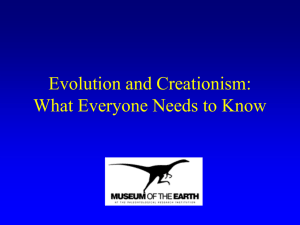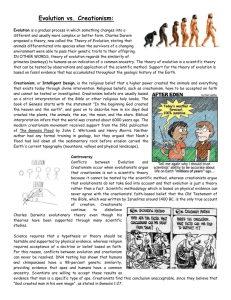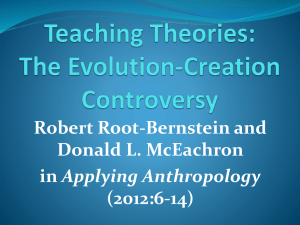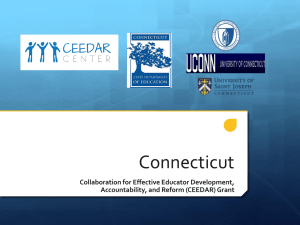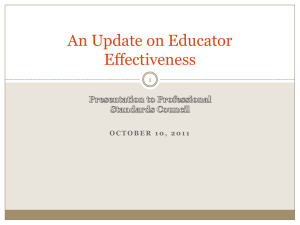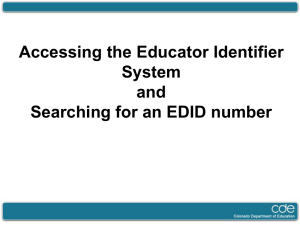Fuller`s File - School of Life Sciences
advertisement
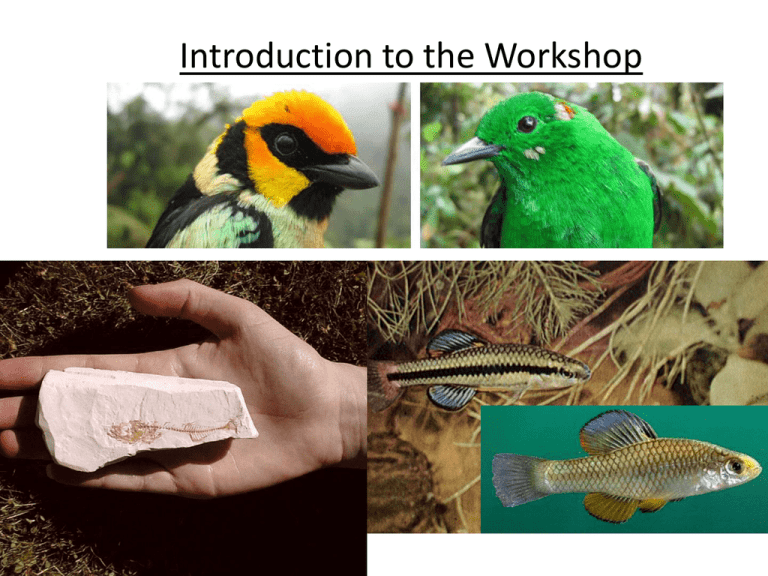
Introduction to the Workshop The State of Evolution Education in the Public Schools Galileo and Heliocentrism U.S. law supports the teaching of evolution. http://ncse.com/taking-action/ten-major-court-cases-evolution-creationism Public opinion concerning evolution. Gallup Polling – Do you believe that human beings were created pretty much in their present form at one time within the last 10,000 years or so? -December 2010 – 40% said yes National Science Foundation’s Science Literacy survey – 39% percent of Americans believe that it is not true that human beings, as we know them today, developed from earlier species of animals. - 2010. Pew Forum poll found that 45% reject the idea that ‘Evolution is the best explanation for the origins of human life on earth.’ - 2007 Pew Research Center 2013 33% say that humans existed in their present form since the beginning. 60% say that humans of evolved but . . . - half of these say that humans evolved due to natural processes such as natural selection. - half say that “a supreme being guided the evolution of living things for the purpose of creating humans and other life in the form it exists today.” Berkman & Plutzer, American Educator, Summer 2012 Evolution in the public schools. Pew Research Center – 57% of the public feels that creationism should be taught along with evolution in the public schools. Only 33% opposed this proposal. Of the 33% opposing this proposal, 1/3 thought that only creationism should be taught (not both). Only 22% of the public supports the teaching of only evolution in the science classroom. Berkman & Plutzer, American Educator, Summer 2012 Nobody likes making people angry. My aunt and her husband who are very anti-evolution. I have several other family members that I could have used as an example. Teachers are in a hard spot. How do ‘advocates of evolution’, ‘cautious’, and ‘advocates of creationism’ teach? Berkman & Plutzer, American Educator, Summer 2012 Surveyed 900 ninth and tenth grade biology teachers across the country (49 states) from various economic levels. Advocates of Evolutionary Biology 1. “When I do teach evolution (including answering student questions), I emphasize the broad consensus that evolution is fact even as scientists disagree about the specific mechanisms through which evolution occurred.” (Agree or strongly agree) 2. “Evolution serves as the unifying theme for the content of the course.” (Agree or strongly agree) 3. “I believe it is possible to offer an excellent general biology course for high school students that includes no mention of Darwin or evolutionary theory.” (Disagree or strongly disagree) 28% of biology teachers Advocates of Evolutionary Biology 1. They do not present evolution as a theory in crisis in any way. 2. They recognize and teach that evolution is an established scientific finding supported by evidence so overwhelming it has taken on the status of scientific fact. 3. They lace evolution throughout their courses. “I tell students that I teach evolution as a topic in biology because all other biological functions are based in evolution.” “The natural selection process is interjected into almost every topic I cover.” “We compare the process, knowledge, societal value and types of questions that are answered by both organized religion and science. We recognize each serves a different purpose and they do not conflict.” “I have been able to present an extensive unit on evolution in an ultra-conservative rural school with minimal negative feedback. I have done this by 1. trying to teach what science is, 2. how science and religion ask different questions, and 3. by presenting evidence that science and religion are not in conflict.” Berkman & Plutzer, American Educator, Summer 2012 Advocates of Creationism 1. When I do teach about creationism or intelligent design (including answering student questions), I emphasize that this is a valid, scientific alternative to Darwinian explanations for the origin of species. 2. When I do teach creationism or intelligent design (including answering student questions), I emphasize that many reputable scientists view these as valid alternatives to Darwinian theory. 13% of biology teachers Berkman & Plutzer, American Educator, Summer 2012 Advocates of Creationism Advocates of creationism teach both creationism (at least one hour) and minimize instruction in evolution. “I don’t teach the theory of evolution in my life science classes, nor do I teach the Big Bang Theory in my earth science classes. There is just too much science and inquiry that we do not have time to do something that is at best poor science.” “I am always amazed at how evolution and creationism are treated as if they are right or wrong. They are both belief systems that can never be truly or fully proved or discredited as man was not present at the beginning to satisfy his or her curiosity as to the nature of the situation.” Teachers who are advocates of creationism support teaching both sides. “I teach evolution/creation as an inquiry process. I use classroom text as well as other sources backing evolution/creation. I have several useful videos backing both areas. My goal is to make students analyze and think to arrive at their own educated decisions.” Berkman & Plutzer, American Educator, Summer 2012 The Cautious Middle 60% of teachers fall into neither group. Large and diverse group. One in ten is a cautious or closet creationist: they do not qualify as advocates of creationism because they do not incorporate it into their lesson plans. However, they validate creationism as credible science when prompted by their students. 85% of the cautious middle accepts evolution. - They do not teach that (a) evolution is central to all biology, (b) that evolution has occurred, and (c) that hypotheses based on evolutionary theory have been confirmed by many scientific studies. - Instead, they employ techniques that reduce the likelihood of sparking controversy. But these are the same techniques used by advocates of creationism. Berkman & Plutzer, American Educator, Summer 2012 The Cautious Middle – Avoiding Controversy Three main controversy avoidance techniques showed up repeatedly in the poll. 1. Micro vs. macroevolution. – Teach evolutionary biology as it applies to within-species changes. Insects evolve pesticide resistance. Bacteria evolve resistance to anti-biotics, etc. But they do not expose students to the idea that (a) microevolution leads to speciation and (b) all life on earth shares common ancestry. Problem: Advocates of creationism do the same thing. Here’s a quote from an advocate for creationism: “I distinguish between microevolution as fact and macroevolution as theory.” One of modern creationism’s three pillars is that evolution – at least macroevolution – is not well-established science. Berkman & Plutzer, American Educator, Summer 2012 The Cautious Middle – Avoiding Controversy 2. Teaching to the test. - Many states require a knowledge of evolution on their science literacy tests. Teachers can get some protection from this. They aren’t choosing to teach it. The state requires it. “I have always started the evolution unit by telling the kids that I don’t care if they believe in evolution or not . . . Just understand it enough to answer the Regents test questions.” Here’s a similar quote from an advocate for creationism. “I tell my students to learn the information for purposes of only passing the state test to graduate.” When teachers dissociate themselves from science by invoking the test, they undermine evolution in the minds of the students. Among major scientific principles, only evolution is so frequently approached as something that students need to know for the test, not because it is solid science. Berkman & Plutzer, American Educator, Summer 2012 The Cautious Middle – Avoiding Controversy 3. Students should make up their own minds. – Students should be exposed to explanations other than evolution – scientific or not. Bills and policies requiring or encouraging teachers to “teach the controversy” or to teach the “gaps” in evolution are an increasingly popular creationist tactic to undermine evolution. These arguments are advanced as supporting “critical thinking” or “critical analysis.” This idea plays well because it seems “fair”. Here are some quotes from creationist advocates. “To be a true scien[tist], you have to present both evolution and creationism!” “I let the students know up front that I have a creationist view point of how life was created. I use the word ‘model’ to explain evolution (‘evolution model’). I bring in the ‘intelligent design model’ to question the ‘evolution model.’” Berkman & Plutzer, American Educator, Summer 2012 MISCONCEPTION: Teachers should teach "both sides" of the evolution issue and let students decide — or give equal time to evolution and creationism. CORRECTION: Equal time does not make sense when the two "sides" are not equal. Religion and science are very different endeavors, and religious views do not belong in a science classroom at all. In science class, students should have opportunities to discuss the merits of arguments and evidence within the scope of science. Galileo and Heliocentrism The Cautious Middle – Avoiding Controversy 3. Students should make up their own minds. Problem – With only 10-15 class hours devoted to evolution, it is not realistic to expect that students are really equipped to assess and perhaps reject hundreds of scientific papers. This approach tells students that science is not a cumulative body of highly technical knowledge, but is instead something that has some element of personal preference. Berkman & Plutzer, American Educator, Summer 2012 The Cautious Middle Given that most teachers in the cautious middle accept evolution, why do they employ teaching tactics utilized by advocates of creationism? Some research suggests that the cautious middle does not feel sufficiently confident to unabashedly teach evolution. Berkman & Plutzer, American Educator, Summer 2012 % Completed College Evolution Course Teacher Knowledge of Evolution Matters 100 75 56% 50 37% 33% 25 0 Advocates of Evolution Cautious Middle Advocates of Creationism Teacher Knowledge of Evolution Matters % Rated Knowledge Above Average or Exceptional 100 82% 75 54% 50 50% 25 0 Advocates of Evolution Cautious Middle Advocates of Creationism Goal #1: Increase knowledge/comfort with evolution. Goal #2: Present several activities for in-class use that touch on several aspects of evolution. Goal #3: Create lesson plans for teachers to use in courses with activities aligned to the Next Generation Science Standards. A Few Websites Next Generation Science Standards Understanding Evolution - Berkley Understanding Science - Berkley Evolution in the News - Berkley National Center for Science Education National Evolution Synthesis Center – Education and Outreach EVO-ED – 4 examples of understanding evolution through multiple subdisciples
